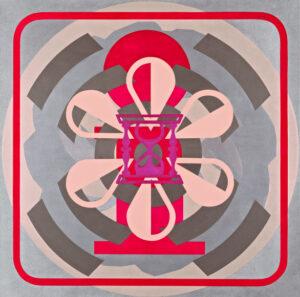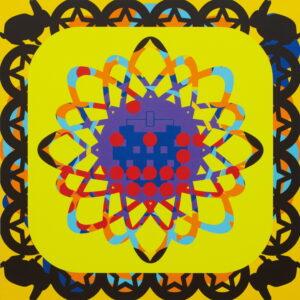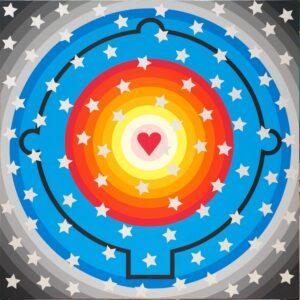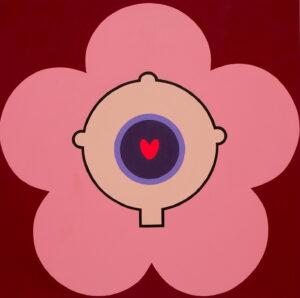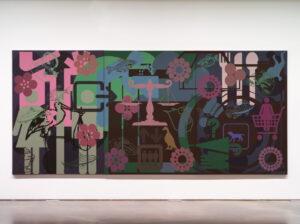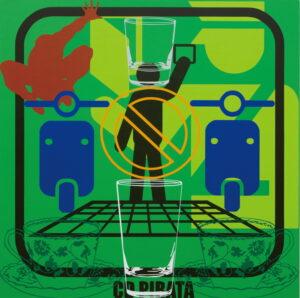





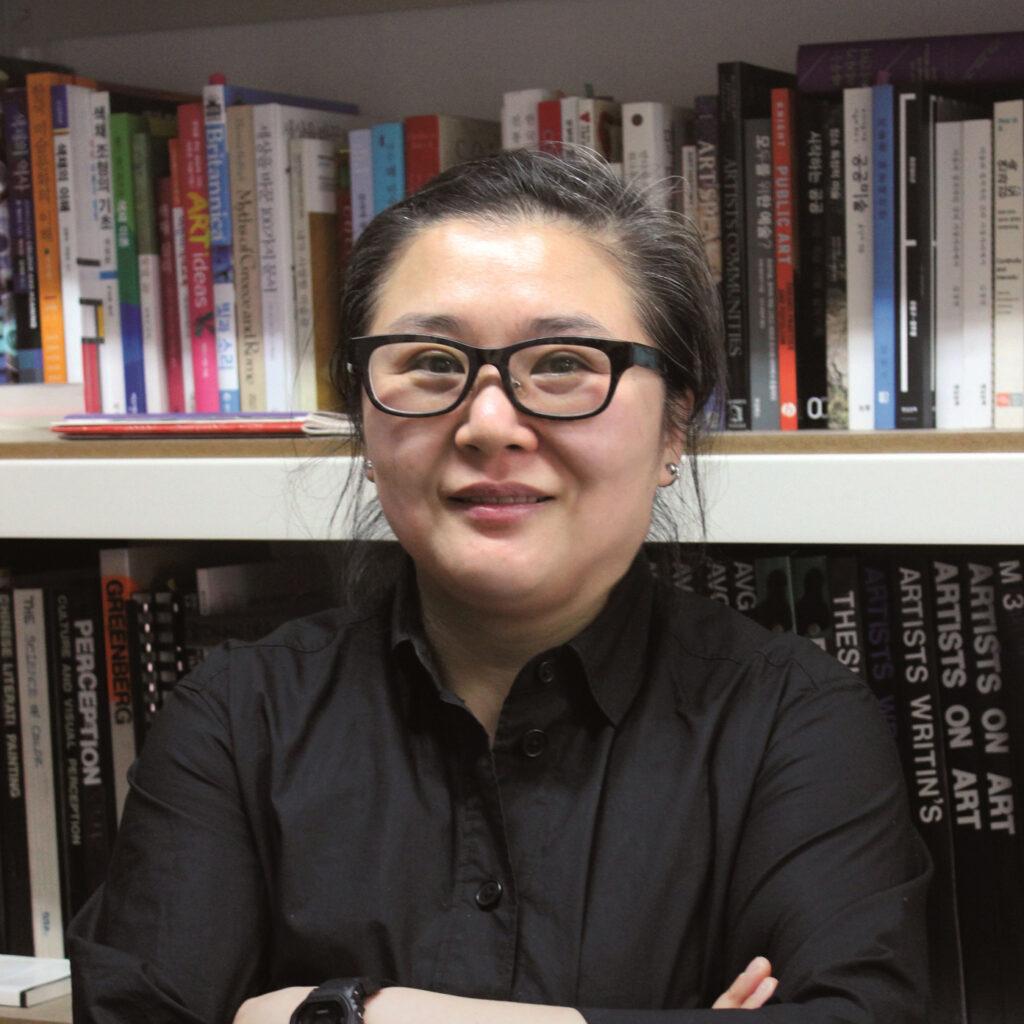
Park Meena graduated from the Department of Painting at the Rhode Island University of Art, USA (1997) and obtained a master’s degree from the Department of Painting at Hunter University Graduate School (1999).
Park Meena explores the production, distribution, consumption methods, and environment of colors/images that surround us and expresses them with the form of painting. Her work looks like abstract painting or design work that uses art and language as formative elements.
However, it can be said that her work is an analogical and metaphorical painting in the sense that she presents a point of view that distinguishes the structure of society and culture through color and shape.
- Works for Sale
- Artistic Career
- World of Work
- Activity
Concept Paintings from Digital Images
Concept Paintings from Digital Images
Solo Exhibitions (Brief)
Park Meena had her first solo exhibition at the Banson Hall Gallery (Providence, USA) in 1996 and made her debut in the Korean art world with the group exhibition《Relay Relay》at Insa Art Space (Seoul, Korea) in 2000.
She held her first solo exhibition at Seoul Auction House (Seoul, Korea) in 2002, the year she started making her name as the 4th artist of Ssamzie Space Residency.
After her first solo exhibition, in her 20 solo exhibitions, she has been showing vigorous activity, focusing on the series Color Collecting, Scream, Dingbat Painting, and House.
Group Exhibitions (Brief)
Yangju Chang Ukjin Museum of Art (Yangju, Korea), Seoul Museum of Art (Seoul, Korea), Kumho Museum of Art (Seoul, Korea), Museum of Modern and Contemporary Art (Seoul, Korea), Ilmin Museum of Art (Seoul, Korea), Samsung Museum of Art Plato (Seoul, Korea) Korea), Gwangju Design Biennale (Gwangju, Korea), Doosan Gallery (New York, USA), International Center for Contemporary Art (Rome, Italy), etc. participated in numerous domestic and international group exhibitions.
Awards (Selected)
In 2020, she was awarded the Minister of Culture, Sports and Tourism’s citation (Korea Copyright Commission’s “Copyright Education Experience Center” building facade in Jinju Innovation City, Gyeongsangnam-do) and the first Doosan Yonkang Arts Award in 2010.
Collections (Selected)
Her works are in the collections of Museum of Modern and Contemporary Art (Seoul, Korea), Seoul Museum of Art (Seoul, Korea), Leeum Samsung Museum of Art (Seoul, Korea), Ilmin Museum of Art (Seoul, Korea), and Bank of Germany (Hong Kong).
Concept Paintings from Digital Images
Concept Paintings from Digital Images
Originality & Identity
Park Meena explores the production, distribution, consumption methods, and environment of colours and images surrounding us. By showing the cross-sectional reality being in the form of colours and paintings, her art presents a point of view that differs from the structure of society and culture.
Park Meena addresses the research gap regarding the group of colours and forms that she works on in her paintings (1995) and < Rhythm & Speed >(1995).In her successive artwork, < Autumn Sky >(1995), she begins to experiment with her unique method of collecting colours forming a database and connecting them with the works.
This experiment was continued by a series of ‘colour paintings’ or ‘paintings for pigment collection,’ represented by < Orange Painting >(2002~2003) and < 2004-Blue-Sofa >(2004). Her series artwork expanded to < Color Landscape >(2003~2020), a diagram artwork created by collecting murals painted with unique pigment from a specific region. Also, the adapted tone and style is referred to the indigenous colours of a particular city.
Park Meena , taking the form of painting as her main research topic from 2002, shows the progression and variation of her painting styles in her work ‘Scream’(2001~2019) series. From 2005, her art style and theme were proactively introduced in her works, specifically in the ‘Scream’ series revealing the industrial order of paint itself by researching the arrangement and operation of colours, forms, and contents.
Dingbat Painting, which she proactively introduced as an art style, is a series to reveal her attention to the relation between language and image. It is well shown in the 《Home Sweet Home》(Project Space Sarubia-dabang, Seoul, Korea) series.
Dingbat font becomes an ‘image-letter’ replacing the language in this work. The paintings are recomposed in various ways and presented with an indecipherable title. Dingbat naturally shows a section of contemporary visual culture that could be interpreted in different circumstances as combined or juxtaposed on one screen.
Meanwhile, Park Meena has also continued drawing for a long time, represented by the ‘Drawings’(1998~2020), and ‘Pen’ series. She continuously asks questions about the performance and the rule of how to test the drawing convention with the fundamental forms, such as colour, form, and composition.
She has been exploring part of the industrial ecosystem and sociality of materials due to her attitude of taking the social structure as her art materials. Her works reflect the way the audience would be inspired to perform both roles of record and painting at the same time. It causes a new issue in the historical discourse in terms of the notion of the painting.
Style & Contents
Park Meena’s work begins with the collection and purchase of drawing materials. The subjects she selects are mainly related to ‘colour,’ such as objects as samples showing specific features like paints, ballpoint pens, or colour samples extracted from the sky (in a certain period; minutes or hours) set by her.
The artist also collects ready-made images such as the Dingbat symbol and drawing paper for colouring books being the basis of her artwork. She categorizes, organizes, and analyses the materials collected, by her made archetypes. The data (component) is reused as an icon with a different meaning through the process of enlargement, transformation, repetition and mixing.
Likewise, resetting the artist’s systematic and clear working style became a condition for the creation, such as painting with colours and forms.
Park Meena’s works have been regarded as minimalism and monochrome painting since her debut as an artist of Korean Pop or similar categories. Even if her drawing is more like graphical factors, it is shown as an abstract painting, in which she uses the basic shapes and details.
However, she has continued extensive experimentation and inquiry into paintings within the scope of a pre-determined visual culture, such as art materials in distribution, the preferences of the art market, and socio-cultural customs.
Therefore, it may be better to define her artworks not as a branch of art but as “meta-painting using the social foundation as working materials or supportive factors”.
*Geun-Jun LIM, 「Some of the facts I know about MeeNa Park’s Art and an incomplete interpretation」, p. 1, 2017.
Constancy & Continuity
When the postmodern painting paradigm lost its effectiveness and the art world wandered under the grand discourse of identity and multiculturalism, Park Meena’s artworks became prominent in the mid-1990s. She studied new methods to recreate the world, not budging from following the contemporary art trend.
As her research method and expression were distinct and famous, some of her painting techniques received comparatively less attention.
Recently, there are works shown that refer to or share Park Meena’s artistic consciousness putting on a discussion with her colour research or materialistic approach as a beginning (or a motif). However, some of these works only show superficial objects (copied formality) or a lack of philosophy after her research inquiries. In the middle of these fakenesses, Park Meena’s work gets clearer to achieve the critical concept of her working methods.
The specialized meaning of her paintings is that she expands the concepts of ‘drawing’ and ‘its methods,’ which have been somewhat narrowly defined in Korea. Further, her artworks provide a chance to rethink the socio-cultural conditions and the structure of the painting style.
Since the early 2000s, Park Meena has participated in international art fairs such as Art Basel (Switzerland) and Armory Show (USA).
Participating in a group exhibition MeeNa Park continues to showcase her works in Asia (Japan, Hong Kong, and Taiwan) and in Western areas (Czech Republic, Spain, Italy, and United States).
Concept Paintings from Digital Images
Concept Paintings from Digital Images
Concept Paintings from Digital Images
Concept Paintings from Digital Images
- Works for Sale
- Artistic Career
- World of Work
- Activity
Concept Paintings from Digital Images
Concept Paintings from Digital Images
Solo Exhibitions (Brief)
Park Meena had her first solo exhibition at the Banson Hall Gallery (Providence, USA) in 1996 and made her debut in the Korean art world with the group exhibition《Relay Relay》at Insa Art Space (Seoul, Korea) in 2000.
She held her first solo exhibition at Seoul Auction House (Seoul, Korea) in 2002, the year she started making her name as the 4th artist of Ssamzie Space Residency.
After her first solo exhibition, in her 20 solo exhibitions, she has been showing vigorous activity, focusing on the series Color Collecting, Scream, Dingbat Painting, and House.
Group Exhibitions (Brief)
Yangju Chang Ukjin Museum of Art (Yangju, Korea), Seoul Museum of Art (Seoul, Korea), Kumho Museum of Art (Seoul, Korea), Museum of Modern and Contemporary Art (Seoul, Korea), Ilmin Museum of Art (Seoul, Korea), Samsung Museum of Art Plato (Seoul, Korea) Korea), Gwangju Design Biennale (Gwangju, Korea), Doosan Gallery (New York, USA), International Center for Contemporary Art (Rome, Italy), etc. participated in numerous domestic and international group exhibitions.
Awards (Selected)
In 2020, she was awarded the Minister of Culture, Sports and Tourism’s citation (Korea Copyright Commission’s “Copyright Education Experience Center” building facade in Jinju Innovation City, Gyeongsangnam-do) and the first Doosan Yonkang Arts Award in 2010.
Collections (Selected)
Her works are in the collections of Museum of Modern and Contemporary Art (Seoul, Korea), Seoul Museum of Art (Seoul, Korea), Leeum Samsung Museum of Art (Seoul, Korea), Ilmin Museum of Art (Seoul, Korea), and Bank of Germany (Hong Kong).
Concept Paintings from Digital Images
Concept Paintings from Digital Images
Originality & Identity
Park Meena explores the production, distribution, consumption methods, and environment of colours and images surrounding us. By showing the cross-sectional reality being in the form of colours and paintings, her art presents a point of view that differs from the structure of society and culture.
Park Meena addresses the research gap regarding the group of colours and forms that she works on in her paintings (1995) and < Rhythm & Speed >(1995).In her successive artwork, < Autumn Sky >(1995), she begins to experiment with her unique method of collecting colours forming a database and connecting them with the works.
This experiment was continued by a series of ‘colour paintings’ or ‘paintings for pigment collection,’ represented by < Orange Painting >(2002~2003) and < 2004-Blue-Sofa >(2004). Her series artwork expanded to < Color Landscape >(2003~2020), a diagram artwork created by collecting murals painted with unique pigment from a specific region. Also, the adapted tone and style is referred to the indigenous colours of a particular city.
Park Meena , taking the form of painting as her main research topic from 2002, shows the progression and variation of her painting styles in her work ‘Scream’(2001~2019) series. From 2005, her art style and theme were proactively introduced in her works, specifically in the ‘Scream’ series revealing the industrial order of paint itself by researching the arrangement and operation of colours, forms, and contents.
Dingbat Painting, which she proactively introduced as an art style, is a series to reveal her attention to the relation between language and image. It is well shown in the 《Home Sweet Home》(Project Space Sarubia-dabang, Seoul, Korea) series.
Dingbat font becomes an ‘image-letter’ replacing the language in this work. The paintings are recomposed in various ways and presented with an indecipherable title. Dingbat naturally shows a section of contemporary visual culture that could be interpreted in different circumstances as combined or juxtaposed on one screen.
Meanwhile, Park Meena has also continued drawing for a long time, represented by the ‘Drawings’(1998~2020), and ‘Pen’ series. She continuously asks questions about the performance and the rule of how to test the drawing convention with the fundamental forms, such as colour, form, and composition.
She has been exploring part of the industrial ecosystem and sociality of materials due to her attitude of taking the social structure as her art materials. Her works reflect the way the audience would be inspired to perform both roles of record and painting at the same time. It causes a new issue in the historical discourse in terms of the notion of the painting.
Style & Contents
Park Meena’s work begins with the collection and purchase of drawing materials. The subjects she selects are mainly related to ‘colour,’ such as objects as samples showing specific features like paints, ballpoint pens, or colour samples extracted from the sky (in a certain period; minutes or hours) set by her.
The artist also collects ready-made images such as the Dingbat symbol and drawing paper for colouring books being the basis of her artwork. She categorizes, organizes, and analyses the materials collected, by her made archetypes. The data (component) is reused as an icon with a different meaning through the process of enlargement, transformation, repetition and mixing.
Likewise, resetting the artist’s systematic and clear working style became a condition for the creation, such as painting with colours and forms.
Park Meena’s works have been regarded as minimalism and monochrome painting since her debut as an artist of Korean Pop or similar categories. Even if her drawing is more like graphical factors, it is shown as an abstract painting, in which she uses the basic shapes and details.
However, she has continued extensive experimentation and inquiry into paintings within the scope of a pre-determined visual culture, such as art materials in distribution, the preferences of the art market, and socio-cultural customs.
Therefore, it may be better to define her artworks not as a branch of art but as “meta-painting using the social foundation as working materials or supportive factors”.
*Geun-Jun LIM, 「Some of the facts I know about MeeNa Park’s Art and an incomplete interpretation」, p. 1, 2017.
Constancy & Continuity
When the postmodern painting paradigm lost its effectiveness and the art world wandered under the grand discourse of identity and multiculturalism, Park Meena’s artworks became prominent in the mid-1990s. She studied new methods to recreate the world, not budging from following the contemporary art trend.
As her research method and expression were distinct and famous, some of her painting techniques received comparatively less attention.
Recently, there are works shown that refer to or share Park Meena’s artistic consciousness putting on a discussion with her colour research or materialistic approach as a beginning (or a motif). However, some of these works only show superficial objects (copied formality) or a lack of philosophy after her research inquiries. In the middle of these fakenesses, Park Meena’s work gets clearer to achieve the critical concept of her working methods.
The specialized meaning of her paintings is that she expands the concepts of ‘drawing’ and ‘its methods,’ which have been somewhat narrowly defined in Korea. Further, her artworks provide a chance to rethink the socio-cultural conditions and the structure of the painting style.
Since the early 2000s, Park Meena has participated in international art fairs such as Art Basel (Switzerland) and Armory Show (USA).
Participating in a group exhibition MeeNa Park continues to showcase her works in Asia (Japan, Hong Kong, and Taiwan) and in Western areas (Czech Republic, Spain, Italy, and United States).

